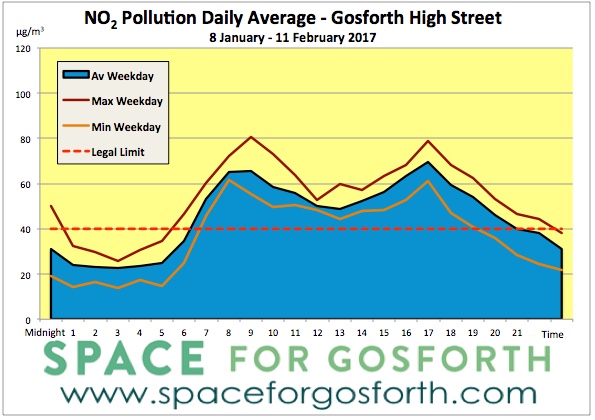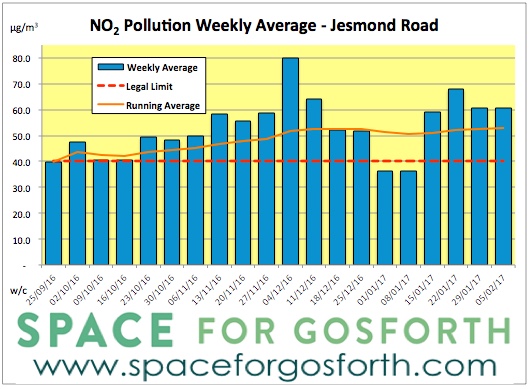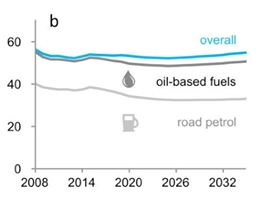In previous posts we looked at air quality data on Gosforth High Street and on Jesmond Road in the run up to Christmas last year, which showed a marked increase in pollution after Black Friday, 25 November 2016. In this post we look at what has happened to air quality at these sites since then.
Gosforth High Street
As we might expect, air quality improved over the school Christmas holidays when traffic was lighter, with readings reducing to 23.8 μg/m3 from the post-Black Friday average of 50.3 μg/m3.
After the school holidays, the NO2 figures started to rise again to 45.5 μg/m3, so not as high as before, but still higher than prior to Black Friday and higher than the annual legal limit.
This average however hides some large variation and, as the graph below shows, while the week commencing Sunday 8 January was at 20.2 μg/m3 the best week so far for air quality, the week commencing Sunday 5 February was the worst at 59.3 μg/m3.
Overall, the average from the Salters Road car park monitors since 25 September 2016 is 39.9 μg/m3. If pollution remains at the same high level as for recent weeks then this will very soon be higher than the annual legal limit. This itself though is a maximum and we should be aiming at much lower levels in order to protect the health of residents, commuters and others that use the High Street.
Jesmond Road
At Jesmond Road the pattern is similar with the average reducing to 38.0 μg/m3 over school holidays from 67.1 μg/m3 before, then increasing again to 56.9 μg/m3 for the period 8 January to 11 February 2017.
Similar to Gosforth, the weeks commencing 1 and 8 January are equal best for air quality at the Jesmond Road monitoring site at 36.2 μg/m3 but two weeks later is the second worst week so far at 68.0 μg/m3. The average to date is 52.5 μg/m3, 32% over the annual legal limit.
Outlook
While we don’t yet have a full year’s worth of data, what we do have supports a strong need for action both in Gosforth and on Jesmond Road to enable alternative travel choices that can help improve air quality including walking, cycling and the use of public transport.
Further house building north of Newcastle including 715 new houses to be built in Cramlington is likely to make this worse especially when, according to SENRUG (the SE Northumberland Rail User Group) current rail services are only hourly during the day with no services between 18.20 and 20.00 during the week and none at all on Sunday.
At the same time, improvements in clean engine technology seem to have stalled with research for the Transport and Environment Group showing that “New cars consume on average 42% more fuel on the road than advertised in sales brochures” and that there has been “No improvement in average efficiency of new cars for four years”. Other research from the International Council for Clean Transportation has shown that “Modern diesel cars produce 10 times more toxic air pollution than heavy trucks and buses“. This they attribute to stricter testing of larger vehicles.
Government Vehicle Licensing Statistics relating to Ultra-Low Emission Vehicles (ULEV) show that these were 1.2% of all new vehicle registrations in the year to September 2016. However, with a 2.3% increase in total vehicles there are still more non-ULEVs on the road than there were a year ago and a 2015 Government report on Energy and Emission Projections suggests (as per the diagram below) that oil-based fuels and petrol are likely to power the vast majority of vehicles until well into the 2030s.
As we set out in our blog Black Friday Part 2 – Newcastle City Centre the Government, and by extension local Councils, are required to cut NO2 pollution to legal levels in the “shortest possible time” so clean engine technology, while worth supporting for the long term, appears unlikely to make any immediate difference.
Other measures that seek to reduce congestion by increasing the vehicle (as opposed to people-carrying) capacity of roads, but instead induce more traffic, will just add to the problem.
Madrid, Paris, Milan and Rome have implemented emergency measures, temporarily banning certain types of traffic from the roads. In the UK, many cities including London are considering clean air zones where highly polluting vehicles are either banned or are charged to use the roads. Nottingham has implemented a work-place parking levy and has used the money to invest in improving public transport. While these restrictions may be effective, they still need to be accompanied by investment in alternative ways of travelling.
For Newcastle, creating a range of good quality options for how people travel, rather than designing roads solely for vehicle flow, will mean people can choose how they get around instead of being forced to use a car. At the moment the choice not to drive is unavailable to many people here. Enabling that choice will help reduce the negative consequences of excessive amounts of traffic, including air pollution, that affect the whole community whether they drive or not.






The pollution is added too by the ridiculous Salters road junction where traffic is queuing for ages because there is only one lane both north and south- before the ” improvements ” there was two
And this means more difficulty for cyclists turning right into Salters Road from the North as traffic from the South along Gosforth High Street tries to beat the lights on the right hand turn before cutting in to the North Lane and narrowly missing any cyclists waiting to turn. Advice to cyclist- keep well back of the arrow point on the turn.
Stewart, Thanks for your comment.
It’s worth noting that the only comparable data we have from previous years actually showed higher readings than those since the junction was changed, which by itself suggests that air quality may not be worse than before.
The single lane configuration, if anything, is likely to have reduced concentrations of pollutants at the monitoring site as there is only one lane of traffic rather than two. Re-introducing two lanes would quite possibly make air quality and road safety worse at that site and probably not help vehicle flow either because right-turning vehicles would prevent use of the second lane.
It’s about time we are having a longer and wider debate about this serious issue and in particular about the local impacts. I often wonder what would have been the case if we had widespread local measurements when I was growing up in the late 60’s and into the 70’s, given the peak which occurred in the early to mid 70’s for most air pollutants in my lifetime so far. The fact that UK wide NOx has reduced by two-thirds since then and PMs by just over two thirds should not stop us from highlighting this issues and the effect it is having on certain local areas and its contributory and compromising effect on shortening lives. Given the above am I right in thinking it is 3 times more likely that air pollution will have had some effect on my life expectancy, than if I was born now?
Improved testing and technology and continuing health research will go some way to reducing impacts and focusing choices we, authorities and governments make, but if governments only act upon national figures and local authorities are scared to act for investment/financial reasons, then it should be upto communities to push the issues locally (and beyond) and that’s where information like that on this website, helps to inform.
The increase of national and international coverage on air pollution through such portals as the BBC’s ‘SoICanBreathe’ website series last week has highlighted additional information to feed into the debate. We have read stories about the increased impact of wood burning stoves in London for instance and also in the French Alps, where during certain winter conditions they make up 80% of certain pollutants. Gas central heating contributing nearly 40% of NOx in central London has been highlighted and also the contribution of brake dust from both road vehicles and trains. And of course not forgetting diesel powered vehicles and shipping. And when you drive along the A1 at any time of the week you suddenly realise how we have become so dependent upon diesel powered road and shipping long haulage, both nationally and globally.
What we have is a multi-faceted countrywide problem which will require multi-faceted solutions, however this is likely to take some time across all issues and solutions as it simply isn’t (shouldn’t be) a matter of banning/restricting buses or diesel cars of a certain age or type. However at a local level where we see national limits exceeded this is likely to be the easiest solution. Will NCC be brave and pursue such a (limited?) solution or will it wait for further government guidance. Will it be in the end an ‘air quality’ tax via fuel cost rises and will this extra tax be spent on national, regional or local initiatives.
With regards the ‘graphs’ presented in what is becoming a monthly update, is there any way the background levels of pollutants can be highlighted and explained. This has always puzzled me in terms of where it comes from and what are the sources and how many times? it is measured. So for instance why is it that at 2am on any particular morning, NO2 levels are at three quarters of the way to the average ‘legal’ limit?
Paul, Thanks for sharing your thoughts.
The patterns we’ve found in our graphs strongly suggest traffic is the main source for pollution in Gosforth, though no doubt it will not be the only source.
The air quality targets we report on were intended to be met in many cases in 2005. The lack of action to date in cities all round Europe is what is leading to the more dramatic responses we see now. Even with the urgency from having lost several court cases the national level of investment in non-polluting alternatives in the UK is exceptionally low. And if there aren’t any carrots (the alternatives) the answer can only be some form of ‘stick’ no matter how unpopular that might be.
It would be good to talk through your other points too. If you are around on Saturday (18 March) we’ll be in Gosforth Central Park at the People in the Park event.